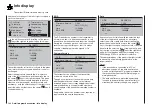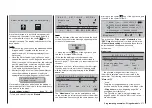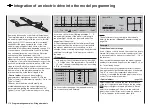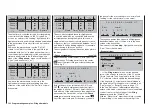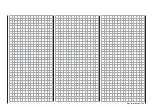
268
Programming examples - Winged models
mc-20
HoTT programming
Preparatory measures based on the example of a winged model
Programming models in an
mc-20
HoTT …
… is easier than it may appear at fi rst!
The primary prerequisite for "clean" programming,
and this applies not only to the
mc-20
HoTT but is
also a principle for all programmable transmitters, is a
mechanically correct installation of all remote control
components in the model! Therefore, it should be
ensured no later than on connection of the linkages
that the servos are in their respective neutral position
and their rudder lever is also in the desired position.
Otherwise you should loosen the rudder and re-
fasten it with an offset of a few lobes. If servos are
positioned with the help of a servo tester, e.g. RC
tester, order no.
2894.12
, then the "correct" positions
can be determined very easily.
The possibility of changing the neutral position of a
servo in practically every modern transmitter is only
intended for
fi ne-tuning
. Greater deviations from "0"
can result to further asymmetries in the course of
the further signal processing in the transmitter. In the
same manner: A car with a bent chassis does not get
any straighter if only the steering wheel is trimmed to
"straight"!
An additional important point is the adjustment of
the rudder paths: This should take place through
a corresponding adjustment of the steering points,
insofar as possible. Ultimately this is far more effi cient
than extensive efforts with the path adjustments in the
transmitter! In this case: Path adjustments serve fi rst
and foremost for to compensate for the manufacturer-
stipulated tolerances for the servos and their
fi ne-
tuning
, and less for the compensation of carelessness.
If two separate aileron servos are used for a
winged model, the ailerons, controlled through
the corresponding activated wing mixer – see the
following pages – can be assigned with both the fl ap
function and raised with the brake fl aps – however this
would make more sense in a glider or electro glider
than in a motor model.
In this case the rudder arms – starting from the neutral
position – should be tilted forward one lobe, pointing
toward the nose, set to the respective servo.
The mechanical differentiation achieved through this
asymmetric assembly contributes to the fact that the
brake effect of the elevated ailerons increases with
their defl ection and, therefore, does not normally
require a greater path upward than downward.
Correspondingly, when planning to operated
separately controlled fl ap servos, they should also be
integrated into a crow system. Since the brake effect
of this fl ap position referred to as a "crow position"
is infl uenced less by the elevated ailerons than the
downward defl ection of the fl aps, the rudder arms
should be installed somewhat toward the rear in
this case, tilted toward the trailing edge. As a result,
there is a greater available path for the downward
defl ection. With such a combination of lowered fl aps
with raised ailerons, however, the latter should only
be elevated moderately, because they have more of
a stabilizing and controlling function than a braking
function in this type of crow system.
A "tip" for seeing the brake effect in this connection:
lift the fl aps and look over and under the surface from
the front. The greater the projected surface of the
protruding rudder, the greater the brake effect.
Outboard ailerons
Inboard camber-changing flaps
(Similar asymmetric installation of rudder arms can
be meaningful, e.g. for open-cowl fl aps or landing
fl aps, even in a motorized model.)
If a model is completed and mechanically attuned
in this respect, you can basically begin with the
programming of the transmitter. The following
examples, an attempt is made to follow the practice
of fi rst describing the general basic settings and then
fi ne-tuning or specializing them in the subsequent
steps. After the initial fl ight and over the course of the
further fl ying in of a model, it may be necessary to
occasionally adjust some of the settings. As a pilot's
experience increases, however, so does the desire for
enhancements and expansions of settings. For this
reason, the sequence of options is not always adhered
to or some options are even mentioned multiple times.
Of course, just the opposite can also be the case,
that not everyone of the described steps is relevant
for a certain model, just as some users may miss the
description of a certain step for their model …
whatever the case may be, you should consider a
logical assignment of the control mechanisms before
you begin with the model programming.
For models in which the emphasis is on the "motor",
regardless of whether it is powered by an electric or
combustion motor, there should be no problem in this
respect, because the assignment of the two joystick
units essentially lies in the four basic functions
"Power regulation (= throttle)", "Side", "Altitude" and
"Transverse"! However, in the menu …
Summary of Contents for 32032
Page 1: ...33020 mc 20HoTT 2 en Programming Manual o Pro Pro mc 20 mc 20...
Page 15: ...15 For your notes...
Page 21: ......
Page 27: ...27 For your notes...
Page 41: ...41 For your notes...
Page 53: ...53 For your notes...
Page 59: ...59 For your notes...
Page 63: ...63 For your notes...
Page 93: ...93 For your notes...
Page 97: ...97 For your notes...
Page 141: ...141 How is a ight phase programmed...
Page 145: ...145 For your notes...
Page 155: ...155 For your notes...
Page 175: ...175 For your notes...
Page 203: ...203 For your notes...
Page 219: ...219 For your notes...
Page 253: ...253 For your notes...
Page 283: ...283 For your notes...
Page 321: ...321 For your notes...
Page 322: ...322 For your notes...
Page 323: ...323 For your notes...













